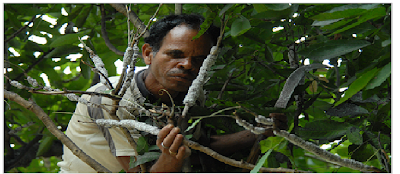 |
| Image Credit: PRADAN website (www.pradan.net) |
Understanding Chhattisgarh’s Livelihood Landscapes Through PRADAN’s Initiative

By Samik Adhikari, Deepti K.C.
In a series to understand the ground realities of livelihood opportunities for the poor, CMF is currently interviewing a set of recognized practitioners. In our first episode, we feature Saroj Mahapatra, Programme Director, PRADAN – Chhattisgarh. PRADAN is a non-government, non-profit organization which works across seven of the poorest states in India with more than 2.68 lakh rural families to improve lives of the rural poor, by instigating systems that expand sustainable livelihood opportunities.
Chhattisgarh is one of the poorest Indian states according to the measures defined by the Human Development Index (HDI). PRADAN aims to organize women from rural families into Self Help Groups to enhance their sense of agency and livelihood capabilities for developing secured livelihood opportunities.
Agro-climatically, the entire state of Chhattisgarh falls in the category of Zone VII (Eastern plateau and hills zone) and can be subdivided into three sub agro-climatic zones. North and South Chhattisgarh have similar characteristics in terms of natural endowments and demographic profiles. Central Chhattisgarh is characterized by the presence of industries and more urbanization from rest of the state. The tribal communities of Chhattisgarh inhabit the densely forested, mineral-rich districts of North and South. Chhattisgarh’s southern region has been in the limelight because of the on-going Maoist insurgency, including a recent 13 day capture of the district collector. Mr.Mahapatra says, “The southern region houses the Bastar Plateau, one of the most problematic and deprived zones. It is heavily forested, with almost 50% of the belt covered by forests”.
Further, Mr. Mahapatra explains, “Here in Chhattisgarh, more than 80% population depends on agriculture. Main crops are paddy, maize, pulses and oil seeds Over 70% of the total workers excluding marginal workers are engaged in cultivation or as agricultural laborers However agriculture is rain-fed as only 21% of the net sown area is irrigated. Though 67% of the total cropped area is rice, the productivity of rice per hectare is very less. Agriculture is the major source of income for the rural households in Chhattisgarh and income from agriculture is supplemented by income from wage labor, forest produce and livestock.”
Major developmental challenges of the area are lack of food security from cultivation, low production levels leading to less investment in husbandry of resources, limited irrigation infrastructure, limited participation of women in mainstream agriculture, underdeveloped markets and services related to agriculture, limited accessibility to government schemes, and over-dependency on eroding Non Timber Forest Produce (NTFP). PRADAN’s experience of working in various poverty pockets of Chhattisgarh indicates that positive changes in the immediate micro environment through appropriate processes and technologies can bring about the desired changes in the quality of life of people and overall economic impact in the local area. According to Mr. Mahapatra, “PRADAN teams are following the comprehensive intervention approach for sustainable impact of livelihoods at the family level through community mobilization for mutual support among members, solidarity, and leveraging resources from government – creating assets, bringing resources under integrated farming system and utilizing them in an optimal but sustainable manner, increasing the productivity and total production of existing crops, and adopting new technology on farm and forest based livelihoods.”
One of PRADAN’s major drives in the last couple of years has been the introduction and promotion of an innovative rice production technique called System of Rice Intensification (SRI) with small and marginal farmers. This methodology aims to increase the productivity of rice by early transplantation of seedlings, transplanting one seedling per heel at wide spacing, and ensuring weeding and hoeing. “PRADAN has partnered with 11 other NGOs from the state to advocate this system across 16,500 farmers in 404 villages in 11 districts. The state government of Chhattisgarh has now shown interest in the drive and is willing to get this strategy across to 50,000 farmers. Currently, the production capacity of paddy in Chhattisgarh is low at about 2 metric ton per hectare, however, the potential to increase productivity to 5.5-6 metric ton per hectare exists”, says Mr.Mahapatra.
Pradan also works to enhance and improve forest based livelihood opportunities by backing scientific cultivation of lac and tasar, host plants that are available in the forest fringe areas in Chhattisgarh. When asked whether forest based livelihood interventions are affected by the protectionist policies of the local authorities, Mr.Mahapatra was quick to highlight that such programs are carried out in conjunction with government agencies such as the Department of Forest, Government of Chhattisgarh.
Highlighting the gaps in implementing livelihood programs for the poor and how research could help fill some of the holes, Mr. Mahapatra expressed the requirement of needs assessment studies. He said it was imperative to understand the micro-economic household behavior especially in the tribal regions. Such studies will help practitioners and service providers such as Pradan identify what strategies are needed to navigate certain conflict prone zones. Pradan is seeking to understand the emerging livelihood sectors in the state, in order to replicate interventions that have worked well. It is also important to understand the geographical context of the state as the north and the south are environmentally different from the more developed central regions. As Chhattisgarh is primarily a mono-crop region, he directed researchers to look at innovative paddy production techniques.
Samik Adhikari and Deepti K.C.
The authors would like to thank Mr. Saroj Mahapatra from PRADAN for answering a list of questions on livelihood activities in Chhattisgarh and for making necessary edits to this article.




